GREAT MUSIC FIGURES — MUGHAM TRIADS
.jpg)
Mirza Asad oglu Sadig (1846–1902) or Sadigjan — musician, tar player, composer, and artist who perfected Azerbaijani tar.
Like all the people of Shusha, Sadig tries himself in the performance of folk songs and mughams from an early age. The point is that during the condolences in Muharram since singing lamentations was considered a good deed, poor families who could not invite well-known singers to their homes, taught their children to sing from an early age. There were even special music festivals and schools in Shusha for this purpose. Almost all famous singers and musicians took students and taught them. Many of the graduates of these assemblies and schools later became famous throughout the East, gaining respect at weddings, concerts, and folk festivals.
Sadigjan is one of the most famous tar players in Azerbaijan. Sadikjan perfected the tar and expanded the possibilities of virtuoso playing in this instrument. He added jingana (two pairs of strings) and root strings, increasing the number of strings from 5 to 11. He also completely changed the system of grip on the neck of tar, reducing their number from 27-28 to 22. Sadigjan introduced important innovations in Azerbaijani mugham, improved "Segah" and "Mirza Huseyn Segahi" and improved "Mahur" mugham. The origin of "Mahur-Hindi", "Orta Mahur", "Zabul Segah", "Kharij Segah", "Mirza Huseyn Segahi", "Etim Segah", "Choban Bayati" in Azerbaijani mugham is connected with Sadigja's creativity and Azerbaijani history.
In the 1890s, an ensemble was formed in Shusha under the leadership of Sadigjan. The ensemble included well-known singers and musicians of that time. Well-known students of the style — Gurban Pirimov, Mashadi Jamil Amirov, Mashadi Zeynal Hagverdiyev, Shirin Akhundov, Mardi Janibeyov, Hamid Malibeyli, and others.
Jabbar Ismayil oglu Qaryagdioglu (1861–1944) — khananda (singer), composer, musician..jpg)
Jabbar Qaryagdioglu grew up in the second half of the 19th century and is one of the most prominent singers in the history of Azerbaijani music. A new stage in the art of Azerbaijani singing is associated with his name. Jabbar Qaryagdioglu took mugham lessons at Harrat Gulu's school in Shusha. At the same time, the rich musical environment of Shusha played an exceptional role in the development of Jabbar. The Russian poet S. Yesenin called him "the prophet of Eastern music". Jabbar, who was very popular in Karabakh, Ganja, Shirvan, and Baku, was also known in the Caucasus, Central Asia, and Iran. Jabbar Qaryagdioglu was the first singer in the history of music that perform mugham from the theater and concert stage. Thus, Jabbar Qaryagdioglu played the role of Majnun in the musical stage "Majnun at Leili's grave" staged in Shusha in 1897 under the direction of prominent writer-dramatist Abdurrahim bey Hagverdiyev. He was also an active participant in the "Oriental Concerts". Jabbar performed in Shusha with a group of musicians by Mirza Sadig Asad oglu, in 1900-1905 in Baku with tar player Mirza Jafar and kamancha player Mashadi Gulu. In 1905, he formed a trio of tar player Gurban Pirimov and kamancha player Sasha Oganezashvili. The trio has been active for more than 20 years. During 1906-1912, Jabbar Qaryagdioglu's voice was recorded on a gramophone in Kyiv, Moscow, and Warsaw by "Sport-Record", "Extafone" and "Gramophone" joint-stock companies. These are the first records in the history of Eastern music. On his return from Warsaw in 1912, he gave "Oriental Concerts" in Moscow. J.Garyaghdioglu performed all classical mughams and many tasnifs with great skill. In particular, his "Heyrati", "Mansuriyya" zarbi mughams, "Mahur", "Shahnaz" mughams are unique examples in our musical history. Jabbar knew classical poetry perfectly. Unlike his predecessors, Jabbar for the first time in the art of singing sings ghazals in the Azerbaijani language in mughams and tasnifs. He performed ghazals of Fuzuli, Gasim bey Zakir, Seyid Azim Shirvani, Khurshidbanu Natavan, and other Azerbaijani poets at concerts and gatherings. It was by singing ghazals and poems in his native language that he spread mugham among the people. Jabbar was also known as a composer and poet. Among the classifications created by him are "Istekanin deshilsin", "Tiflisin yollari", "Iravanda khal galmadi", "Nakhchivan gediyinden asheydim" and others. About 300 songs and tasnifs performed by him were recorded in the Scientific-Research Cabinet of Folk Music headed by Bulbul at the Azerbaijan State Conservatory, many songs and tasnifs were transcribed and published by U.Hajibeyov, M.Magomayev, S.Rustamov.

Kechachioglu Mohammad (Mohammad Mashadi Khalil oglu) (1864-1940) — Khananda.
He learned the art of singing at the school of Harrat Gulu in Shusha and from the famous singer Mashadi Isi. Along with other prominent representatives of the Karabakh school, he developed the art of mugham in his work and spread the fame of Azerbaijani mugham everywhere. His repertoire included classical mughams, tasnifs, and folk songs. The singer, who has a wide range, strong and ringing voice, skillfully sang all mugham dasgahs and zarbi mughams. Kechachioglu Mohammad was a singer who was demanding of his art and always worked tirelessly on himself. With his mugham s such as "Zaminkhara" and "Humayun", he was able to captivate the audience and amaze them with his unique performance.
Kechachioglu Mohammad sang classical mughams, as well as "Nava", "Mahur", "Bayati-Gajar" mugham in an original way, with its peculiarities. At the same time, he was especially known as a propagandist of zarbi mughams. The singer also won the sympathy of the people with his performances at Oriental concerts. It was especially popular for him to sing scenes with Jabbar Qaryagdioglu from Fuzuli's poem "Leyli and Majnun" as a duet.
His tours should also be noted. Along with singing, he was also engaged in pedagogical activities. Kechachioglu Mohammad devoted all his energy and knowledge to the development of our music culture. In 1926, on the initiative of Uzeyir Hajibeyov, Kechechioglu Mohammad was invited to the Azerbaijan State Conservatory. He brought up many Azerbaijani singers here.
Mashadi Mammad Farzaliyev (1872-1962) — Khananda from Karabakh.
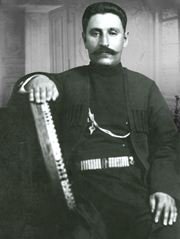
From a very young age, he lived and sang in Ganja, and later in Tbilisi, Batumi, Vladikavkaz, Istanbul, and other cities. He was known as a prominent artist in the Caucasus, Central Asia, Turkey, and even many European countries. While in Shusha, Mashadi Mammad performed at weddings and folk festivals. For the first time, he had great success at the Oriental concert at the Khandamirov's theater in Shusha.
"Bayati-Kurd", "Rast", "Shur", "Chahargah", "Zabul-Segah", "Kurdu Shahnaz", "Heyrati", "Mansuriyya", "Simayi-shams", "Karabakh Shikestasi" sung by Mashadi Mammad , "Arazbari", "Kerami", "Afshari" and other mughams were met with great sympathy by the public. Mashadi Mammad was also more famous as a master of "Shushtar".
Mashadi Mammad Farzaliyev received an invitation in 1912 from the Sport-Record company operating in Warsaw. The voice of the Azerbaijani singer is recorded in Warsaw. Accompanied by tar player Gurban Pirimov, Mashadi Mammad sang about 40 mughams, tasnifs, and songs. After this success, another invitation came from Kyiv. The famous artist recorded mugham and folk songs on a gramophone record by the company "Extrafon". Mashadi Mammad sang Natavan's ghazals the most in his mughams and songs. Mashadi Mammad, known as a famous singer, was invited to Tbilisi (Georgia) in the spring of 1913 by the People's House named after Zubalov. In 1926, Mashadi Mammad Farzaliyev gave concerts in many cities of Russia, Poland, Germany, France, Belgium, England, Austria, Romania, Turkey, and Iran.
.jpg)
Mashadi Jamil Amiraslan oglu Amirov (1875-1928) — tar player, composer, musician.
Although Mashadi Jamil showed great interest in tar from an early age, due to his financial situation, he was a tailor's apprentice. He soon became famous as a tailor in Shusha and even opened a shop. One day, one of the wedding tar players in Shusha came to Mashadi Jamil and asked to sew a dress for him. In return, Mashadi Jamil asks the tar player to teach him to play a few songs on the tar, as a result, Mashadi Jamil connects his life with music. Mir Mohsun Nawwab's musical meetings played an important role in his development as a musician. Mashadi Jamil accompanies Mashadi Mahammad Farzaliyev, Malibeyli Hamidi, Musa Shushinsky, and later Bulbulu and Seyid Shushinsky in Ganja assemblies.
In 1910, Mashadi Jamil was invited to the Gramophone Company in Riga with a group of musicians. Here he writes several mughams and folk songs. In 1911 he went to Istanbul, Turkey to study music. He has been living and studying in Istanbul for about two years. Mashadi Jamil was an active propagandist of Azerbaijani music in Turkey. For the first time, Turks see the tar playing on the chest in Mashadi Jamil. Turkish magazine "Shahbal" publishes a large article about Mashadi Jamil and Azerbaijani music and a photo of him with tar.
Mashadi Jamil is also one of the first in the history of Azerbaijani music to record mughams. In 1912, he recorded "Heyrati" mugham and published it in "Shahbal" magazine. Returning to Ganja in 1913, Mashadi Jamil also brought a bow and oud. In 1915, after a long career, Mashadi Jamil wrote the opera "Seyfal-mulk". After two performances in Ganja, he was invited to Tbilisi (Georgia) and on June 3, 1916, he was staged at the Kozyan Theater in Tbilisi (now the Georgian State Opera and Ballet Theater). After Tbilisi, the opera will be staged in Yerevan. After returning to Ganja, he wanted to open a music school in the city but was not allowed by Tsarist Russia. However, Mashadi Jamil opens a mugham course. Artists such as Seyid Shushinsky, Bulbul, Zulfu Adigozalov, Ali Javad oglu, Abdurrahman Farajov, and Musa Shushinsky benefit from this course. After the establishment of the USSR, Mashadi Jamil created a drama troupe in Ganja. In 1923, after a long struggle, Mashadi Jamil finally received permission to open a music school in Ganja, and in the first year, 39 students were admitted to the school. Mashadi Jamil's son Fikret Amirov, Ganbar Huseynli, Telman Hajiyev, and others are students of this school. Mashadi Jamil Amirov wrote the operetta "Namuslu giz" in 1923, and this work was successfully staged in Ganja.
Abdullayev Islam Abdul oglu (1876-1964) — Khananda.
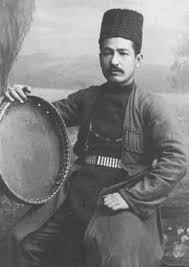
He is one of the prominent representatives of the Karabakh mugham school. In the history of Azerbaijani music, Islam Abdullayev is known as a unique performer of "Segah" mugham.
He was called "Segah Islam" by the people due to his special enthusiasm and ability to perform "Segah" mugham and all its variants — "Zabul-Segah", "Mirza Hussein segahi", "Orta Segah", "Kharij Segah". Islam Abdullayev studied at Shusha city school.
He studied mughams from musicologist Mir Mohsun Navvab, singer Haji Husu and many famous singers of Karabakh, he mastered the art of singing and began to perform accompanied by tar player Mirza Sadig Asad oglu. Islam Abdullayev became famous in Azerbaijan and abroad due to his beautiful and impressive voice and unique performance ability.
In 1910-1915, "Segah", "Bayati-Gajar", "Shahnaz", "Shushtar" mughams, and several tasnifs performed by Islam Abdullayev were recorded on gramophone records by "Sport-Record" and "Extrafon" recording companies.
Islam Abdullayev was a wonderful teacher. He played a great role in the development of singers such as Khan Shushinsky, Yagub Mammadov, Sahib Shukurov. Towards the end of his life, he moved to Aghdam, where he taught mugham at a music school and became a master of many singers.

Gurban Bakhshali oglu Pirimov (1880-1965) — the first People's Artist of Azerbaijan, musician, tar player.
Gurban, who received the blessing of his teacher Sadigjan at the age of 15, accompanies famous singers at Karabakh weddings. At one such wedding, singer Islam Abdullayev saw Gurban playing the tar and took him on. In 1905, Gurban had a successful history. Because at one of the Ganja weddings, Jabbar Qaryagdioglu likes him to play the tar and, with the consent of Islam Abdullayev, brings the young man to Baku. Accompanied by famous singers, the tar player is most often associated with Khan Shushinsky.
Honored Artist of the Republic Firudin Alakbarov, who has been in contact with Gurban Primov for 30 years, has interesting memories of the tar player. He says that Uncle Gurban was an artist who knew our mughams deeply. When the Gurban uncle played the tar, a spark came out of his mizrab: "In his time, there were few microphones. But he never used a microphone. His loud music spread throughout the hall. As soon as he hit the strings, he forced everyone in the hall to listen to him."
Yes, he had his musical features. These were his discoveries, the warmth of his heart. Those who know Pirimov remember that he was also very funny. He always jokingly told the tar players that when someone suddenly throws a stone at you on the way, quickly hide your hands. Protect only your hands. Gurban Primov was right. It was those hands that amazed us and created miracles. The music filtered by the magic of those hands could conquer everyone's heart. Today, our masters continue the path of great artists and do not forget their predecessors. But in the words of Gurban Primov, "Learning is the key to being a master. But every master must have his fingers."
Mirza Mansur Mashadi Malik oglu Mansurov (1887-1967) — tar player.
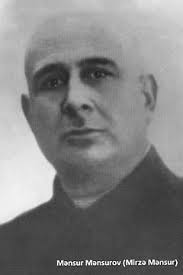
Mirza Mansur Mansurov took advantage of the Baku mugham meetings held at the house of his father Mashadi Malik Bey and decided to become a musician. The prominent tar player has been teaching mugham at the State Turkish Music School organized by Uzeyir Hajibeyov since 1920, and at the Azerbaijan State Conservatory in 1926-1946. At the initiative of Uzeyir Hajibeyov, he developed the first mugham curriculum for the tar class.
Young composers Tofig Guliyev and Zakir Bagirov first wrote musical notes for the mugham s "Rast", "Duga" and "Zabul" performed by Mirza Mansur in the mid-1930s. In 1940, Mirza Mansur Mansurov was awarded the honorary title of Honored Art Worker of the Azerbaijan SSR.
As a creative musician, he also made some changes in the structure of the tar (joining the curtains, strengthening the tar ashugs, etc.). He even made a tar in the new structure. One of the two tars made by Mirza Mansur in a new format in 1934 is successfully demonstrated at the exhibition of art instruments in Paris and the other in Istanbul.
Mirza Mansur has raised a generation of talented musicians in Azerbaijan. Among them are Said Rustamov, Khurshid Agayeva, Anvar Mansurov (son of Mirza Mansur), Rashid Efendiyev, and others.
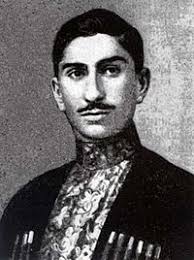
Seyid Shushinsky (1889-1965) — Azerbaijani khananda.
Seyid Shushinsky, who had a unique and beautiful voice, first studied with the Navvab for two years to master the secrets of the art of singing. His next teacher was Jabbar Qaryagdioglu. Seyid Shushinsky sang "Chahargah", complex mugham, with great skill, and he always started it not from "maya" but from "Mansuriyya", he raised his voice and dis zangula's with great skill, and then descend to the "maya." Interestingly, in the last years of his life, the 74-year-old Seyid sang "Mansuriyya" with the same enthusiasm.
Along with the ghazals of Hafiz Shirazi, Mohammad Fuzuli, Seyid Azim Shirvani, Seyid Shushinsky also appealed to the poems of Huseyn Javid and Mirza Alakbar Sabir. Sabir's poem "Millat neje taraj olur olsun, ne ishim var" (No matter how much the nation was plundered, I don't care) was performed in "Mukhalif". Seyid Shushinsky was the first singer to recite poems and gazals on political and social topics, urging people to fight. He also sang a number of warlike songs. "Ayil ey millat" (Wake up, nation), "Men bir Turkam" (I am a Turk), "Millat istarsa" (If the nation wants), and so on.
He was friends with such artists as Seyid Shushinsky, Mirza Jalil, Abdurrahim bey Hagverdiyev, Huseyn Javid, Huseyn Arablinsky. He provided financial support for the publication of several issues of Molla Nasreddin magazine. In general, Seyid Shushinsky was a great patron, he helped a lot of theater actors of that time, and he played several roles as an actor. Besides "Chahargah", Seyid Shushinsky was a great performer of mughams such as "Mahur", "Nava", "Masnavi", "Osmani", "Arazbari", "Heyrati". As an innovative artist, he combined many mughams and sang them in a new version. ("Rast-Humayun", "Gatar-Bayati", "Shur-Shahnaz") Seyid Shushinsky performed "Dilkesh" for the first time in "Rast" and "Kurdi-Shahnaz".
Seyid Shushinsky, as a consultant, provided great assistance in writing the symphonic mugham s "Shur" and "Kurdi-Ovshari", first created by our famous composer Fikret Amirov and gaining world fame.
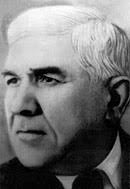
Ahmad Mammadrza oglu Bakikhanov (1892-1973) — tar player, pedagogue, musician.
Ahmadkhan Bakikhanov received his first education in Iran, where he mastered the secrets of tar playing and mugham from master tar players, and from 1920 he played and taught at music meetings and concerts in Baku. From the 1930s, at the invitation of Uzeyir Hajibeyov, he taught mugham at the ASC(Azerbaijan State Conservatory), and later at the ASMS(Azerbaijan State Music School). He was the organizer and leader of the ensemble of folk instruments at the Azerbaijan Radio. Since 1973, the ensemble has been named after Ahmad Bakikhanov. This ensemble accompanied many prominent singers — Jabbar Qaryagdioglu, Seyid Shushinsky, Huseyngulu Sarabski, Zulfu Adigozalov, and others. Tarzan A. Bakikhanov has a great contribution to the promotion of Azerbaijani folk music, especially mughams. He was a deep connoisseur of the art of mugham and was known as a skilled performer of "Nava-nishapur" and "Abu-ata" mughams. At the same time, many melodies and colors created by him are widespread in folk performances.
A. Bakikhanov is the author of such note publications as "Azerbaijan folk colors" (1964), "Azerbaijan rhythmic mughams" (1968), "Mugham , song, color" (1975). These collections are a valuable tool for teaching and researching folk music. His mugham program for music schools is still used in tar teaching.
A. Bakikhanov devoted most of his life to the education of musicians: Habib Bayramov, Ahsan Dadashov, Sarvar Ibrahimov, Aliaga Guliyev, Alikram Huseynov were his students. He was a mugham teacher of many composers (Arif Malikov, Haji Khanmammadov, Nariman Mammadov, etc.). Iranian musicians Ali Salimi and Adil Akhundzadeh were his students.

Zulfu Samad oglu Adigozalov (1898-1963) — Khananda, mugham connoisseur, commentator, and propagandist of tasnifs and folk songs.
Jabbar Qaryagdioglu, who listened to Zulfu Adigozalov's performance at a mugham evening in Shusha, invited him to Baku. In 1927 he moved to Baku and passed the exam of U. Hajibeyov, G. Pirimov, M. Magomayev, and others to work in the "House of Defense" (now the Philharmonic), at the same time he worked in the Radio Broadcasting Committee.
Zulfu Adigozalov was a bass singer. He created a unique school of singing in the full bass and middle tessitura of the mugham. Well-known singers Abulfat Aliyev, Sahib Shukurov, Hajibaba Huseynov, Alibaba Mammadov, Yildirim Hasanov, Agakhan Abdullayev, Talat Gasimov, and others are followers of his school.
"Rast", "Mahur-Hindi", "Segah-Zabul", "Bayati-Shiraz", "Humayun" mughams also several tasnifs, "Nabi", "Men Gedirem Zangilana"( I'm going to Zangilan), "Dedim bir buse ver"( I said kiss me), "Keklik"( Partridge) and so on performed by the singer and recorded on tape and gramophone records. Such folk songs are the pearls of the Azerbaijani musical treasury. It was during the performance of our ancient classical mugham s, tasnifs, and folk songs that the singer introduced innovations in the art of performing with his unique breath and style while retaining their traditional form and structure.
Zulfu Adigozalov independently interpreted mugham as a micro-series, combining separate relevant sections. From this point of view, good examples are the mugham s "Iraq-Punjab", "Hasar-opposition", "Vilayati-Dilkesh".
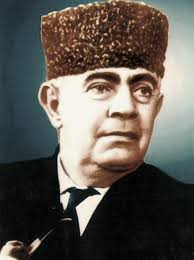
Khan Shushinsky (Isfandiyar Aslan oglu Javanshir) (1901-1979) — Khananda.
When he was 16 years old, his teacher named him "Khan Shushinsky" because he performed the "Kurd-Shahnaz" mugham amazingly — through the way of Tabriz singer Abdulhasan khan. Jabbar Qaryagdioglu and Seyid Shushinsky also had a great influence on khan's upbringing as a singer.
In the 1920s, Khan Shushinsky came to Baku and expanded his performing activities. Along with "Mahur-Hindi", "Bayati-Gajar", "Gatar" mughams, "Karabakh Shikestasi", "Arazbari", "Heyrati" zarbi mughams, folk songs, and tasnifs took a big place in the khan's repertoire. Khan Shushinsky sang folk songs with special enthusiasm, instilling new shades in them.
In 1934, Khan Shushinsky achieved great success at the first Transcaucasian Art Olympiad in Tbilisi (Georgia) and received the first prize. He also represented Azerbaijani musical culture at a high level and worthily in other countries.
He also taught at the Azerbaijan State Music School and created a new generation of mugham singers. As a truly creative artist, Khan enriched the treasury of national music with new songs. From this point of view, his songs "Gamarim", "Shushanin daglari"(Shusha's mountains) were memorized. Khan Shushinsky also addressed the composer's songs in his work. In this sense, he was the first singer of Uzeyir Hajibeyov's song "Gara goz" (Black eyes) and sang it with great pleasure. In 1960, he established the "Mugham Studio" under the auspices of the Azerbaijan State Philharmonic, where he taught young singers the secrets of mugham.
Yavar Abbas gizi Kalantarli (1902-1979) — Khananda.

Everyone in their generation loved mugham and music. But little, sweet, lovely Yavar was told, "A girl should not sing." So he ran to the coal roof and sang there until his heart was empty. The doctor who examined her when she was a famous singer was surprised: "There is a strange harmony in your voice as if you were working in a coal mine." Yavar's relatives tried their best to keep her away from art and the stage. But one day her pleasant voice attracted the attention of composer Uzeyir Hajibeyov. They could not object to the composer's proposal. Yaver completed a one-year music course in 1922.
She saw the stage and loved to sing, and then she got married. After marriage, she was sure that her dream of a stage and her desire to sing came to an end. On November 5, 1924, Yaver sang "Mahur-Hindi" mugham at the event dedicated to the 5th anniversary of the Soviet power in the two-story building of the House of Education. She was accompanied by Badalbey Badalbeyli on tar and Jamo Jabrayilbeyli on violin. After that, Uzeyir Hajibeyov advised her to go to the mugham circle. Yaver Kalantarli took lessons from famous singers Jabbar Qaryagdioglu and Seyid Shushinsky. However, all this led to her divorce from her husband of 18 years. Even after losing her only child, she did not appear on the stage. At Hajibeyli's insistence, she returns to the stage.
She was a soloist of the Azerbaijan Radio and the Azerbaijan State Opera and Ballet Theater.
She performed parties from Leyli, Leyli's mother ("Leyli and Majnun", Uzeyir Hajibeyov), Asli ("Asli and Karam", Uzeyir Hajibeyov), Arabzangi ("Shah Ismail", Muslim Magomayev).
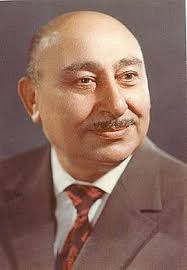
Mansurov Bahram Mashadi Suleyman bey oglu Mansurov (1911-1985) — musician, prominent tar player.
Bahram Mansurov has witnessed music festivals organized at home since childhood. Mugham connoisseurs, musicians, and singers from all over Azerbaijan would gather at these gatherings. Not only prominent musicians benefited from these meetings, but also our famous poets and writers such as Seyid Azim, Khurshudbanu Natavan, Abdurrahim bey Hagverdiyev were in close contact with it and wrote poems in this honor. These assemblies have served as a kind of "people's conservatory" since 1863. This music center later became a school of life for many. There was a lot of tar in their house. As soon as his father left the house, little Bahram immediately took one of the tar hanging from the wall and played on it, unconsciously unrooting it and hung it on the wall. Mashadi Suleiman, who saw Bahram's passion for tar and music, always said to him: "I feel that you will suddenly play the tar. You don't need to be taught." Indeed, from the age of eight, Bahram pressed tar to his chest and tuned his childhood dreams in the fragile strings of tar.
When Bahram Mansurov was 19 years old, Muslim Magomayev invited him to the first orchestra of folk instruments, and then to the Opera and Ballet Theater as a soloist. Bahram Mansurov works on the opera stage with such luminaries as Huseyngulu Sarabski, Yaver Kalantarli, Huseynaga Hajibababayov, Alovsat Sadigov, Hagigat Rzayeva. Rubaba Muradova, Sara Gadimova, Abulfat Aliyev, Gulkhar Hasanova, Zeynab Khanlarova, Mais Salmanov, Bakir Hashimov, Gulu Asgarov, Arif Babayev, Nazakat Mammadova, Baba Mirzayev and others. he attracts these artists to the theater and prepares them for performances. Throughout his career, Bahram Mansurov has accompanied many leading singers — Jabbar Qaryagdioglu, Seyid Shushinsky, Zulfu Adigozalov, Khan Shushinsky, Hajibaba Huseynov, and others with his tar at concerts. He is the first Azerbaijani musician to perform Azerbaijani mughams on a gramophone record and CDs through UNESCO and disseminated them all over the world. He represented Azerbaijan at the International Mugham Symposium held in Samarkand in 1978 and 1983. After Sadigjan, Bahram Mansurov was the only tar player who preserved and promoted classical Azerbaijani mughams. All mughams, daramad, diringa, tasnif and ranglar oglu from his performance were recorded by his son, composer Eldar Mansurov.
Hajibaba Huseynali oglu Huseynov (1919-1993) — Khananda.

He grew up in a clergyman family. At an early age, he used to sing in mosques and mourning ceremonies. Hajibaba Huseynov, who received a record of singer Zulfu Adigozalov in 1938, repeats what Zulfu sings and imitates it. After the end of the war in 1945, Sara Gadimova, a well-known singer at the time and also Hajibaba Huseynov's sister-in-law, introduced Hajibaba Huseynov to Ahmad Bakikhanov, a prominent pedagogue and tar player. Ahmad Bakikhanov employs young Hajibaba in his ensemble. Hajibaba worked in that ensemble for three years. Due to his strong memory, he mastered the samples of religious music and mughams he heard and began to write ghazals, mastering the rules of aruz. At that time, Hajibaba Huseynov learned the subtleties of mugham from the singers, musicians, and Ahmad Bakikhanov who performed with the ensemble, and until the end of his life, he considered Ahmad Bakikhanov as his main master. Although his vocal range was not so wide, his timbre was impressive and pleasant. The singer's diligence and ability to combine poetry and mugham with high artistic taste, which he gained as a result of his hard work and search for art, was highly appreciated by mugham connoisseurs and music lovers.
After the death of Zulfu Adigozalov in 1963, Ahmad Bakikhanov invited Hajibaba Huseynov to teach mugham at the Azerbaijan State Music School. Until the end of his life, Hajibaba Huseynov taught at that school for 30 years and trained singers. Among the students of the singer we have prominent artists — Nazakat Mammadova, Gadir Rustamov, Sakhavat Mammadov, Zaur Rzayev, Teymur Mustafayev, Agil Malikov, Safar Mirzayev, Sabir Aliyev, Bilal Aliyev, Zabit Nabizade, Sahib Ibrahimov and others. Although our prominent artists Agakhan Abdullayev, Mammadbagir Bagirzade, and Alim Gasimov were not direct students of Hajibaba Huseynov, they benefited from his performance and represented the school that he founded. Numerous tasnifs created by Hajibaba Huseynov have entered the musical heritage and are widespread in mugham performance.
Elman Karim oglu Badalov (1929-1991) — kamancha player.
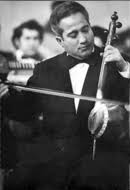
He was engaged in music from a young age and played the tar and kamacha.
He performed in the spectacles and concerts of the Aghdam State Drama Theater, was a laureate of the II Festival of Azerbaijani Youth (1957). In addition, he studied physics and mathematics at the Aghdam Pedagogical School and worked as a teacher (1947-1951). He received professional music education at the Azerbaijan State Music School (1957-1961) and the Azerbaijan State Conservatory (1975-1980).
From 1958 until the end of his life he was a soloist of the Orchestra of Folk Instruments named after S. Rustamov (Azerbaijan Television and Radio Broadcasting CJSC) and accompanist of the kamancha ensemble. Elman Badalov performed with concerts as a soloist and in mugham triads, toured in many countries (Turkey, Japan, Denmark, Sweden, Norway, etc.), and performed at international music festivals.
On kamancha he played Bayati-Shiraz, Dilkesh, Shushtar and, etc. He skillfully performed mughams and works of composers.
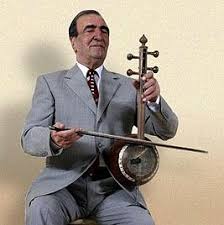
Habil Mustafa oglu Aliyev (1927-2015) — kamancha player.
At the age of seven, he was admitted to the seven-year Aghdash Music School No 3 in the district center. He has been in love with the kamancha ever since. After graduating from the seventh grade and music school, he entered the pedagogical school. Habil Aliyev came to Baku in 1952 and entered the kamancha department of the secondary music school named after Asaf Zeynalli. He began to learn the secrets of the art of mugham from the famous tar player Gurban Pirimov and the famous singer Khan Shushinsky. Gabil's performance attracted the attention of the composer Soltan Hajibeyov. Considering Habil's potential, the composer advised him to work in the Philharmonic. Habil Aliyev began his career in 1953 at the Azerbaijan State Philharmonic named after Muslim Magomayev, first as an accompanist in a dance ensemble, and then as a kamancha player in a trio. Habil Aliyev, who accompanies concerts of artists such as Seyid Shushinsky, Hagigat Rzayeva, Khan Shushinsky, Zulfu Adigozalov, Mutallim Mutallimov, Shovkat Alakbarova, Sara Gadimova, Fatma Mehraliyeva, takes advantage of their immortal heritage, works harder, and does not get tired of training for hours. Habil gave new kamancha life to "Segah", "Bayati-Gajar", "Bastanigar", "Bayati-Shiraz", "Rahab", "Bayati-Kurd", "Jahargah", "Rast", "Zabul" mughams. Habil Aliyev has toured in the former Soviet republics, as well as in many countries around the world, including Turkey, America, Germany, England, France, India, Pakistan, Iran, Egypt, Switzerland, the Netherlands, Tunisia, Japan, Syria, Mozambique, and others.
The master performer not only performs music masterly but is also the author of beautiful songs. More than 15 songs written by him are still sung by famous musicians. Gabil Aliyev's compact discs with Azerbaijani mughams and folk songs have also been released in the USA, France, Japan, Italy, and Greece.
Alibaba Balaahmed oglu Mammadov (1930) — Azerbaijani khananda, composer.
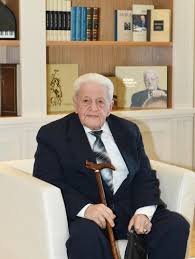
The unique mugham atmosphere of Baku and Absheron villages played an important role in Alibaba Mammadov's upbringing as a singer. Alibaba Mammadov received his musical education in 1953-1958 at the Azerbaijan State Music School in the class of singer Seyid Shushinsky.
From 1945 he was a soloist of the Azerbaijan State Philharmonic, from 1978 to 1988 he was a soloist of "Azkonsert Birligi". In 1968, at the initiative of maestro Niyazi, he founded the Humayun Folk Instrument Ensemble at the Azerbaijan State Philharmonic and still leads it. Alibaba Mammadov has benefited from prominent Azerbaijani singers and is known as a master singer who opened his way in the art of mugham.
Recordings of "Rast", "Bayati Shiraz", "Rahab", "Dashti" and other mughams performed by him with great skill are kept in the AzTV Foundation. Alibaba Mammadov has created more than 100 songs and tasnifs, which are included in the repertoire of singers.
"Yasha mehebbetim, yasha ureyim"(Long live my love, long live my heart), "Gel bize, yar"( Come to us, my love), "Bir denesen"( You are one of a kind) and, etc. These songs, written in the words of Azerbaijani poets such as Fuzuli, Vahid, Mikayil Mushvig, Suleyman Rustam, Bakhtiyar Vahabzade, are preserved in the tape recordings of many prominent singers at the AzTV Foundation. Alibaba Mammadov has been teaching mugham at the Baku Music College since 1963 and has worked hard to raise a generation of young singers. Alibaba Mammadov has also repeatedly been a member of the jury in mugham competitions.
Arif Babayev (1938) — Khananda, professor.
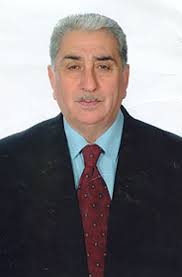
He graduated from the Azerbaijan State Institute of Culture and Arts (1962). He worked at the Azerbaijan State Philharmonic (1963-1966), the Azerbaijan State Opera and Ballet Theater (1966).
He created a unique style of performance based on the traditions of artists such as Seyid Shushinsky, Khan Shushinsky, Zulfi Adigozalov. Starting from 1960, Arif Babayev's creative path was connected with Baku. He studied at the Azerbaijan State University of Culture and Arts. Arif Babayev was first invited to the Azerbaijan State Philharmonic and then to the Azerbaijan State Opera and Ballet Theater as a soloist, created memorable images on the stage of this theater in the mugham operas such as Majnun, Karam (U. Hajibeyov — "Leyli-Majnun", "Asli and Karam"), Ashig Garib (Z. Hajibeyov — "Ashig Garib"), Jamal (Sh. Akhundova — "Gelin Gayasi"). All mugham performances by Arif Babayev were recorded and entered the AzTR Foundation.
In 1982, he began working as the first mugham teacher at the Bulbul Secondary Music School. Then, in 1984, he was hired as the first mugham teacher at the Azerbaijan State Conservatory.
In 1990, he became a mugham professor for the first time in history. The singer was awarded the People's Artist (1988), Professor (1996), "Glory" (1998), and "Independence" (2008), "Honor" (2018) orders. Arif Babayev is one of the prominent representatives of the Karabakh school of singing in the second half of the 20th century.
"Shur", "Seygah" mugham dastgahs, "Arazbari", "Karabakh shikestasi" zarbi mughams have a special place in his work. In particular, Arif Babayev sang "Segah" mugham in a unique style. The singer is also very popular as a performer of tasnifs and folk songs.

Janali Khanali oglu Akbarov (1940) — Khananda, actor.
Janali Akbarov learned the secrets of mugham from his father. Janali Akbarov studied music at the Azerbaijan State Music School in Baku. He learns the rules of singing mugham from his teachers Seyid Shushinsky and Khan Shushinsky and improves his performing skills.
Janali Akbarov has been a soloist of the Azerbaijan State Philharmonic since 1965, and of the Azerbaijan State Opera and Ballet Theater since 1976.
The singer has several memorable characters in mugham operas: Majnun and Ibn-Salam (U.Hajibeyov — "Leyli and Majnun"), Shah Ismayil (M.Magomayev — "Shah Ismayil"), Ashig Garib (Z.Hajibeyov — "Ashig Garib "). Janali Akbarov has repeatedly toured abroad — Germany, Mali, Austria, and others.
He achieved great success at the Oriental Music Symposium in Samarkand and the Oriental Music Festival in Kuybishev. All mughams performed by Janali Akbarov were recorded. Janali Akbarov is currently raising a generation of young singers as a mugham teacher. He is the head of the "Mugham Art" department at the Azerbaijan State University of Culture and Arts.
In 2002 he was awarded the Order of Glory. Janali Akbarov died on October 22, 2021. The master artist was buried in the Second Alley of Honor.
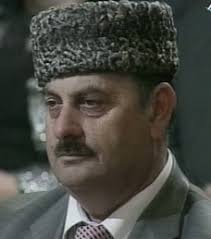
Agakhan Minakhan oglu Abdullayev (1950-2016) — Khananda.
In 1973, he was invited to work as a mugham teacher at the Abilov House of Culture. From 1977 he worked as a mugham teacher at the music school named after A.Zeynalli.
He started performing on the stage of the Philharmonic in 1975. He has given concerts in many countries such as Russia, Kazakhstan, Georgia, Uzbekistan, USA, Canada, Germany, Netherlands, Sweden, Belgium, Austria, France, Australia, India, Iraq, Tunisia, Turkey, Iran, and others.
In 1992 he was awarded the title of Honored Artist of the Republic of Azerbaijan, in 1998 he was awarded the title of People's Artist of the Republic of Azerbaijan. He was a presidential pensioner.
In 2000, he was awarded the Honorary Decree of the Collegium of the Ministry of Education of the Republic of Azerbaijan, In 2001, he was awarded the Simurg National Award Fund of the Republic of Azerbaijan, in 2002, the Humay National Award, and in 2003, the Long Live Azerbaijan Award.
On May 10, 2015, he was awarded the Heydar Aliyev Foundation's Golden Plane International Prize.
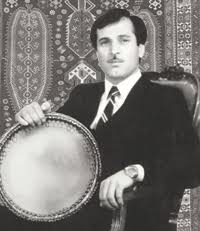
Sakhavat Amirkhan oglu Mammadov (1953-1991) — Khananda.
Sahavat's voice sounded beautifully in Segah, and his soul was attached to Segah. Most of the songs he sang are in the taste of "Segah". "Ay Beri Bakh" (Look at me), "Uja Daglar"( High Mountains), "Yar Bize Gonaq Gelecek" ( The Lover Will Visit Us), "Ay Çiçek" (Flower), "Sarı Bulbul" ( Yellow Nightingale), "Kulek" (Wind) and, etc.
Entering the Music College named after Asaf Zeynalli in 1971, Sakhavat learned the secrets of mugham from the master singer, "People's Artist" Hajibaba Huseynov. In 1976, he became a soloist of the folk ensemble "Humayun". Sakhavat Mammadov, who studied at the State Institute of Arts in 1983-88, represents Azerbaijani mugham in many countries. The instrumental ensemble "Karabakh" created by him still lives as one of the masterpieces of the singer.
The Karabakh instrumental ensemble was formed in the first years of the Karabakh events. With "Karabakh", Sakhavat traveled not only in Karabakh but also in the USSR and European countries, conveying the realities of Azerbaijan to the world along with our mugham.
Sakhavat Mammadov had a unique voice. The singer died in a car accident on September 30, 1991. Due to the war, the tombstone ordered to be placed on Sakhavat Mammadov's grave in Baku could not be delivered because of the heavy fighting in the village. Then the village was occupied. The headstone with Sakhavat Mammadov's picture, date of birth, and death engraved on it remained in the yard of his house in Baku.
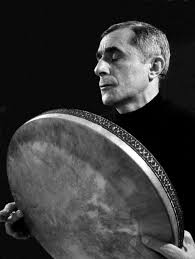
Alim Hamza oglu Gasimov (1957) — Khananda and actor.
He took mugham lessons at the Baku Music School named after Asaf Zeynalli in 1978-1982 and at the Azerbaijan State Institute of Arts in 1983-1989.
He made his first appearance on Azerbaijan Television in 1979. In 1980, he participated in the 22nd Olympic Games in Moscow. In 1982, he won the first Republican mugham competition. In 1983 he joined the International Music Symposium in Samarkand. In 1989, he gave concerts and participated in festivals in Moscow, Paris, Monet, Cologne, Bochum, West Berlin, Fragsburg, Basel, Geneva, Lie, Amsterdam. Since 1991 he has been a member of the Municipal Theater of Paris — "DE-LE-Ville".
In 2000, his "Love's Deep Ocean" disc ranked ninth on the European World Music Map and was played on the radio in 47 European countries. In 2000, he was elected a member of the European Assembly of Rare Voices.
He currently works at the Asaf Zeynalli Music School and the Baku Music Academy. He is a soloist of the Azerbaijan State Opera and Ballet Theater.
In 2009, Alim Gasimov was one of four Azerbaijanis among the world's 500 most influential Muslims in a competition held by Georgetown University in the United States and the Center for Strategic Studies in central Jordan.
On May 26, 2012, Alim Gasimov shared one stage with Sabina Babayeva from Azerbaijan in the final of the 57th Eurovision Song Contest in Baku. In 2015, the opening ceremony of the European Games began with a live mugam performance by Alim Gasimov.



